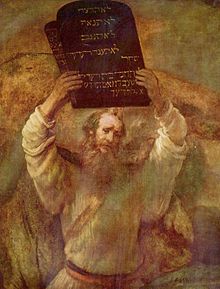- Mount Horeb
-
For other uses of the names Horeb or Mount Horeb, see Horeb.For the biblical Mount Sinai, see Biblical Mount Sinai.
 Moses with tablets of the Ten Commandments, painting by Rembrandt, (1659)
Moses with tablets of the Ten Commandments, painting by Rembrandt, (1659)
Mount Horeb, Hebrew: חֹרֵב, Greek in the Septuagint: χωρηβ, Latin in the Vulgate: Horeb, is the mountain at which the book of Deuteronomy in the Hebrew Bible states that the Ten Commandments were given to Moses by God. It is described in two places (Exodus 3:1, 1 Kings 19:8) as הַר הָאֱלֹהִים the Mountain of God or perhaps Mountain of the gods.[citation needed] The mountain is also called the Mountain of Yhwh.[1]
In other biblical passages, these events are described as having transpired at Mount Sinai, but though Sinai and Horeb are often considered to have been different names for the same place, there is a body of opinion that they may have been different locations.[1]
Contents
Etymology
Horeb is thought to mean glowing/heat, which seems to be a reference to the sun, while Sinai may have derived from the name of Sin, the Sumerian deity of the moon,[2][3] and thus Sinai and Horeb would be the mountain of the moon and sun, respectively.[2]
Other interpreters[who?] show the etymology of Sinai (Hebrew letters: Samech, Yud, Nun, Yud) as being related to the word for bush (Hebrew: סנה, Samech, Nun, Hey), hence Sinai being where Moses saw the Hasneh HaBoeir or the burning bush.[citation needed]
In Matityahu Clark's Etymological Dictionary of Biblical Hebrew, the root for Horev, "Chorev", (Hebrew: חרב, Chet, Reish, Beit) is related to the Hebrew word for sword Cherev (Hebrew: חרב) (again Chet, Reish, Beit) showing the meaning of Chorev being "desolation as after a mighty battle", where the root for Sinai being Sineh (Samech, Nun, Hey) relating to both "bush" and the idea "to fend off an attack". The relationship between "fend off" and "bush" being that this bush has thorns to in fact "fend off" its enemies. Both of these words tend to paint a word picture of a very desolate place that defends itself by the very rough terrain and thorny bushes that surround it.[Need quotation to verify]
Occurrences
According to the researchers of the Documentary hypothesis, the name Sinai is only used in the Torah by the Jahwist and Priestly Source, whereas Horeb is only used by the Elohist and Deuteronomist.[3][4]
The name Horeb first occurs at Exodus 3:1, with the story of Moses and the Burning Bush. According to Exodus 3:5, the ground of the mountain was considered holy, and Moses was commanded by God to remove his shoes.
Exodus 17:6 describes the incident when the Israelites were in the wilderness without water. Moses was upon the rock at Horeb, where he struck the rock (defying God's instruction Numbers 20:1-13) and obtained drinking water from the cracking rock. The only other use of the name in Exodus is at Exodus 33:6, where Horeb is the location where the Israelites stripped off their ornaments.
In Deuteronomy, Horeb is mentioned several times in the account of the wanderings of the Israelites in the wilderness, Deuteronomy 1:2, 1:6, 1:19. The account of the delivery to Moses of the Ten Commandments, and references back to it, include mentions of Horeb at Deuteronomy 4:10, 4:15, 5:2,9:8, 18:16, 28:69. There are similar references back at Psalms 106:19 and Malachi 3:22.
At 1 Kings 8:9 2 Chronicles 5:10 it is stated that the Ark of the Covenant contained only the tablets delivered to Moses at Horeb.
At 1 Kings 19:8, Elijah visits Horeb the mount of God.
There are no occurrences of Horeb under that name in the New Testament. At Galatians 4:24-25, in the Epistle of Saint Paul to the Galatians, Mount Sinai is mentioned: " ... One covenant is from Mount Sinai and bears children who are to be slaves: This is Hagar. Now Hagar stands for Mount Sinai in Arabia and corresponds to the present city of Jerusalem, because she is in slavery with her children."
Location
Main article: Biblical Mount Sinai - Suggested locationsThe location of Horeb is unknown. Jewish and Christian scholars have advanced varying opinions as to its whereabouts since biblical times.[2] Elijah is described in 1 Kings 19:8 as traveling to Horeb, in a way which implies that its position was familiar when that was written, but there are no biblical references set any later in time.
References
- ^ a b Jewish Encyclopedia, Mount Horeb
- ^ a b c "Mount Horeb". Jewish Encyclopedia. http://www.jewishencyclopedia.com/view.jsp?artid=817&letter=S&search=horeb.
- ^ a b Matthew Black and H. H. Rowley, ed (1963). "Exodus". Peake's Commentary on the Bible (second edition ed.). Thomas Nelson. pp. section 178c.
- ^ Harris, J. Rendel (1902). "Sinai, Mount". In James Hastings. A Dictionary of the Bible. http://www.ccel.org/ccel/hastings/dictv4/Page_536.html.
Categories:- Hebrew Bible mountains
- Exodus Stations
- Sacred mountains
- Moses
Wikimedia Foundation. 2010.

